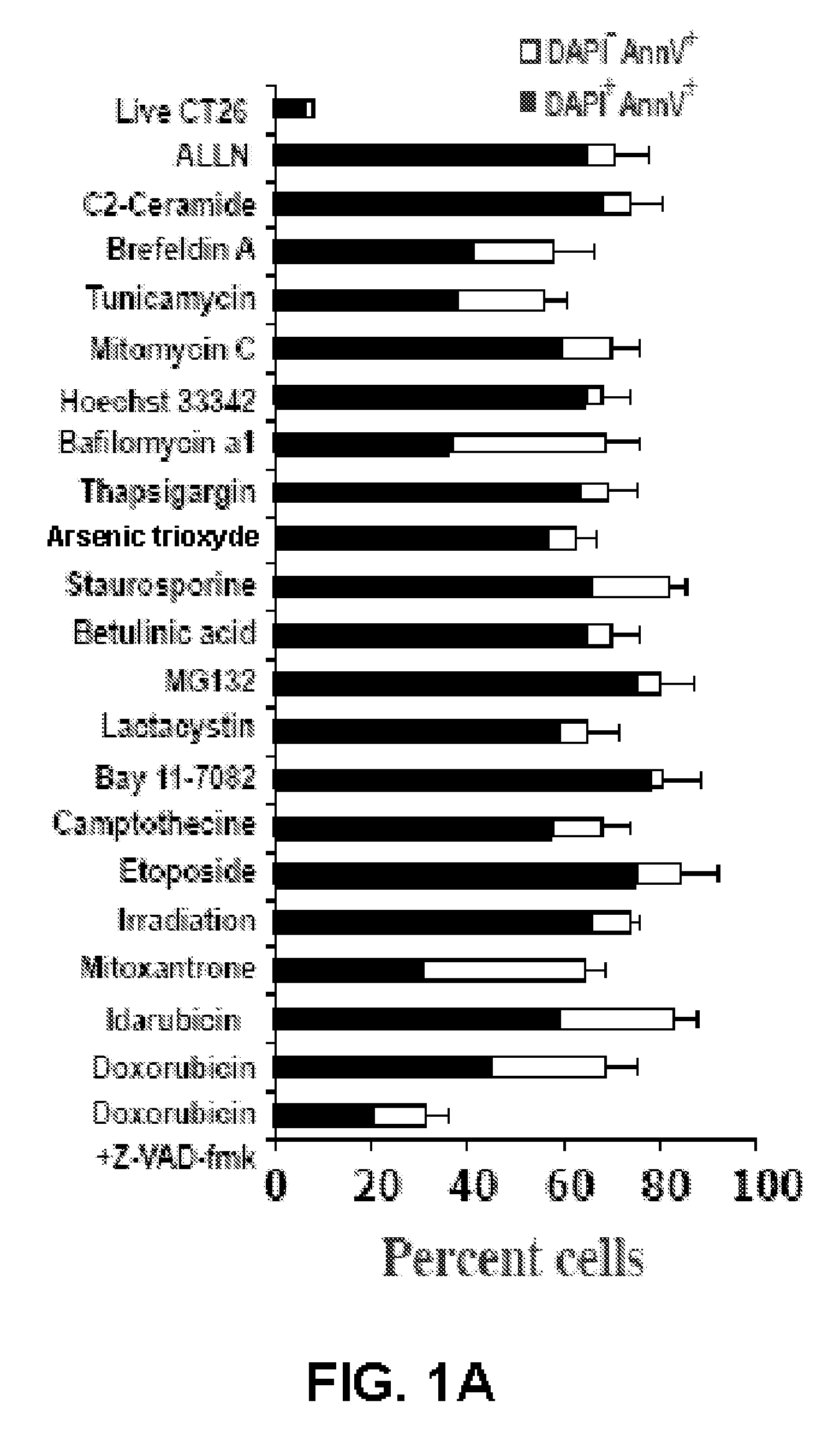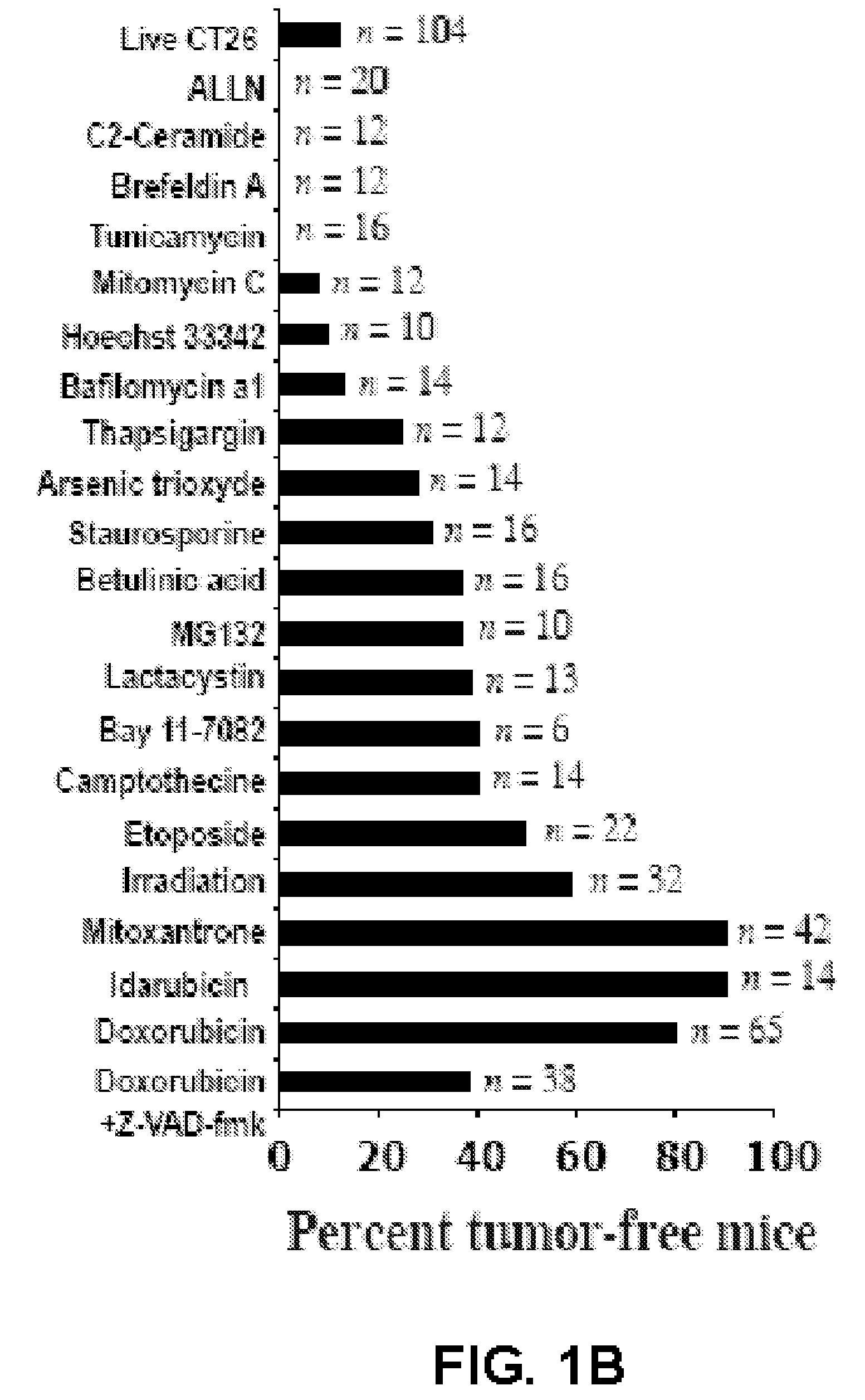Method, apparatus, and compound for effecting localized, non-systemic, immunogenic treatment of cancer
a cancer and immunogenic treatment technology, applied in the field of isolated proteins, can solve the problems of unwarranted immune reaction, cancer is a major cause of mortality, cell death,
- Summary
- Abstract
- Description
- Claims
- Application Information
AI Technical Summary
Problems solved by technology
Method used
Image
Examples
example 1
CRT Exposure Defines Immunogenic Cell Death
[0119]Dying CT26 tumor cells exposed to a panel of −20 distinct apoptosis inducers (all of which induced −70±10% apoptosis, as determined by double staining with the vital dye DAPI and the PS-binding dye Annexin V, FIG. 1A) were injected into one flank of immunocompetent BALB / c mice, followed by rechallenge of the animals with live tumor cells injected into the opposite flank 8 days later. Protection against tumor growth then was interpreted as a sign of anti-tumor vaccination (FIG. 1B) because such protection was not observed in athymic (nu / nu) BALB / c mice. Most apoptosis inducers, including agents that target the endoplasmic reticulum (ER) (thapsigargin, tunicamycin, brefeldin), mitochondria (arsenite, betulinic acid, C2 ceramide) or DNA (Hoechst 33342, camptothecin, etoposide, mitomycin C), failed to induce immunogenic apoptosis, while anthracyclins (doxorubicin, idarubicin and mitoxantrone) elicited immunogenic cell death (FIGS. 1B, C)....
example 2
Requirement of CRT for DC-Mediated Recognition of Dying Tumor Cells
[0120]In view of the established role of CRT as an “eat me” signal it was decided to further investigate the possible implication of CRT in the phagocytosis of anthracyclin-treated tumor cells by DC, a cell type that b stringently required for mounting an immune response against apoptotic tumor cells. Anthracyclin-treated tumor cells acquired the property to be phagocytosed by DC quickly, well before the manifestation of apoptotic changes, within a few hours after treatment with doxorubicin or mitoxantrone (FIG. 3A, FIG. 2S A), correlating with the rapid induction of CRT (FIG. 3B, FIG. 1 S A, B) and the acquisition of immunogenicity (FIG. 2S B). The presence of CRT on the surface of tumor cells treated with a panel of distinct cell death inducers strongly correlated with their DC-mediated phagocytosis, suggesting that CRT is important in mediating the uptake of tumor cells by DC (FIG. 3B). Accordingly, blockade of th...
example 3
Requirement of CRT for Immunogenicity of Dying Tumor Cells
[0122]The knock-down of CRT compromised the immunogenicity of mitoxantrone-treated CT26 cells, and this defect was restored when rCRT was used to complement the CRT defect induced by the CRT-specific siRNA. This result was obtained in two distinct experimental systems, namely (i) when CT26 tumor cells were injected into the flank of Balb / c mice (or MCA205 cells were injected into C57BI / 6 mice) to assess the efficacy of anti-tumor vaccination (FIG. 4A) and (ii) when the turn or cells were injected into the foot pad to measure interferon-7 production by T cells from the popliteal lymph node (FIG. 4B). In this latter system, absorption of rCRT to the plasma membrane surface greatly enhanced the immunogenicity of cells that usually fail to induce an immune response such as mitomycin-treated cells (FIG. 4C). Similarly, etoposide-treated cells coated with rCRT elicited a vigorous anti-tumor immune response in vivo, in conditions in...
PUM
| Property | Measurement | Unit |
|---|---|---|
| pH | aaaaa | aaaaa |
| pH | aaaaa | aaaaa |
| pH | aaaaa | aaaaa |
Abstract
Description
Claims
Application Information
 Login to View More
Login to View More - R&D
- Intellectual Property
- Life Sciences
- Materials
- Tech Scout
- Unparalleled Data Quality
- Higher Quality Content
- 60% Fewer Hallucinations
Browse by: Latest US Patents, China's latest patents, Technical Efficacy Thesaurus, Application Domain, Technology Topic, Popular Technical Reports.
© 2025 PatSnap. All rights reserved.Legal|Privacy policy|Modern Slavery Act Transparency Statement|Sitemap|About US| Contact US: help@patsnap.com



